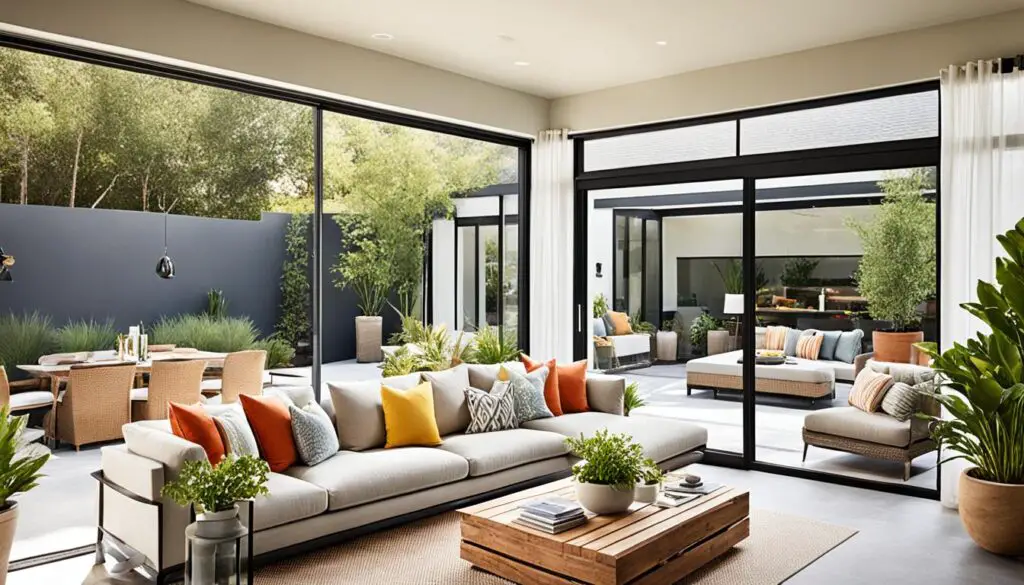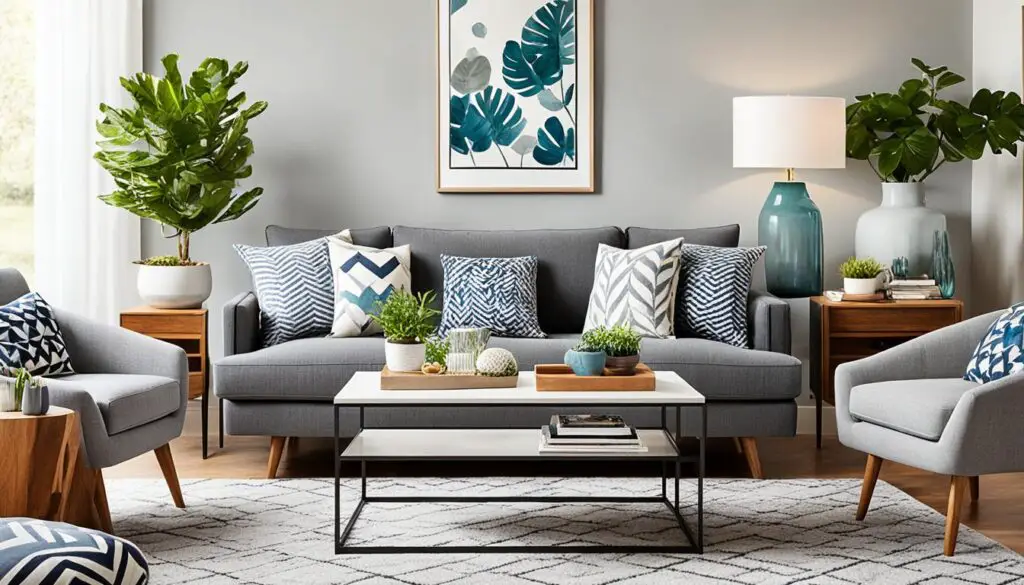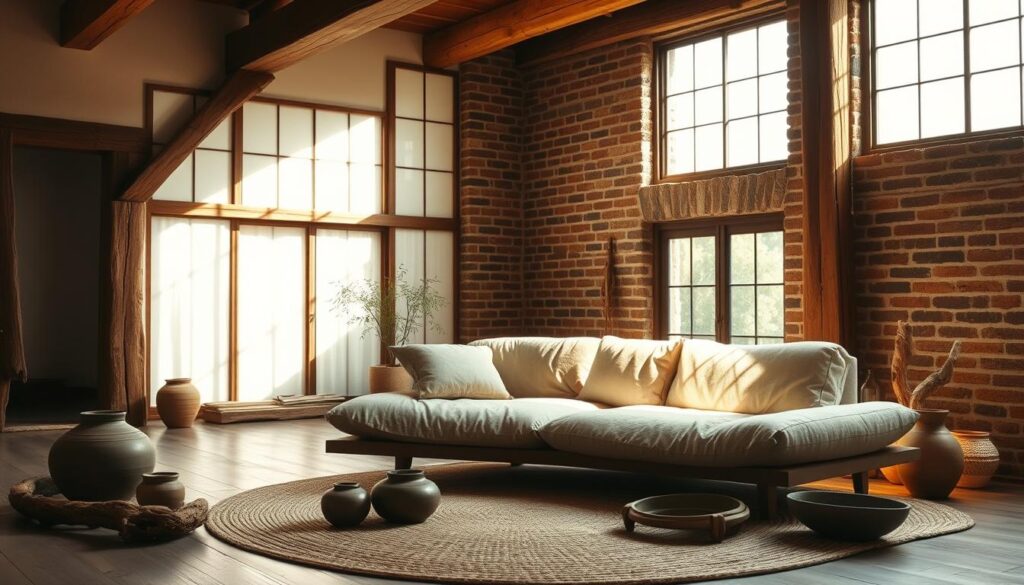
Wabi Sabi is a Japanese way of seeing beauty in imperfection and nature. It started in the 16th century with tea ceremonies. Now, it’s changing how we design our homes.
A wabi sabi living room is all about being real. It has weathered wood, handmade ceramics, and colors like soft grays and warm browns.
Make your living room special with modular sectionals and organic textures. Mix a marble coffee table with wooden armchairs. Add rattan lights and a thick rug for texture.
Even a boho tapestry or black marble in the kitchen can bring in this Japanese feel. Designers like Alena Valyavko and Studio IMA show how to create calm spaces. They use distressed wood, clay pottery, and natural fibers.
By embracing imperfection and nature, you can make your home a peaceful wabi sabi retreat.
Understanding Wabi Sabi Philosophy
Wabi Sabi is more than a design style; it’s a way of thinking. It finds beauty in things that are imperfect and unfinished. It values being real over being perfect, finding happiness in the imperfections of things.
The Beauty of Imperfection
Wabi Sabi sees beauty in imperfection. Things like cracked pottery or weathered wood are not flaws but stories. This view is different from the usual push for perfection.
A vase with a chip or a rug that’s faded tells a story of time and use. It’s a reminder of the passage of time.
“Wabi Sabi’s enso symbol—a loose, incomplete circle—captures this essence. Its unfinished shape mirrors life’s impermanence.”
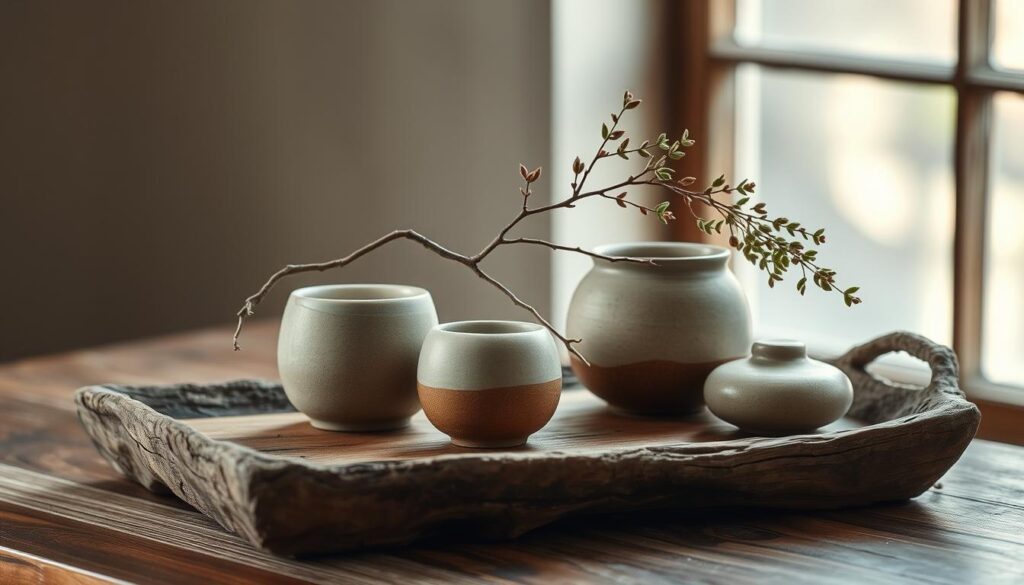
Embracing Natural Materials
Wabi Sabi focuses on natural materials. Wood, stone, and clay are used in their raw form. They are not polished but allowed to age naturally.
- Wood: Unpainted oak or reclaimed planks show growth rings and grain patterns.
- Stone: Rough-hewn slabs add earthy weight and durability.
- Cotton/linen: Textiles with subtle irregularities feel warm and lived-in.
| Material | Wabi Sabi Advantage |
|---|---|
| Unfinished wood | Highlights organic grain and aging process |
| Hand-thrown pottery | Showcases maker’s fingerprints and intentional asymmetry |
| Woven jute rugs | Emphasizes natural fibers and subtle imperfections |
Using natural materials also helps the environment. Choosing reclaimed wood or handmade items is good for the planet. The way light falls on these materials creates shadows that highlight their authenticity.
Key Elements of Wabi Sabi Design
Starting a wabi sabi living room interior design inspiration means embracing imperfection and organic textures. This style turns flaws into beauty, creating spaces that are both cozy simplicity and rustic. Here’s how to make these principles come alive:
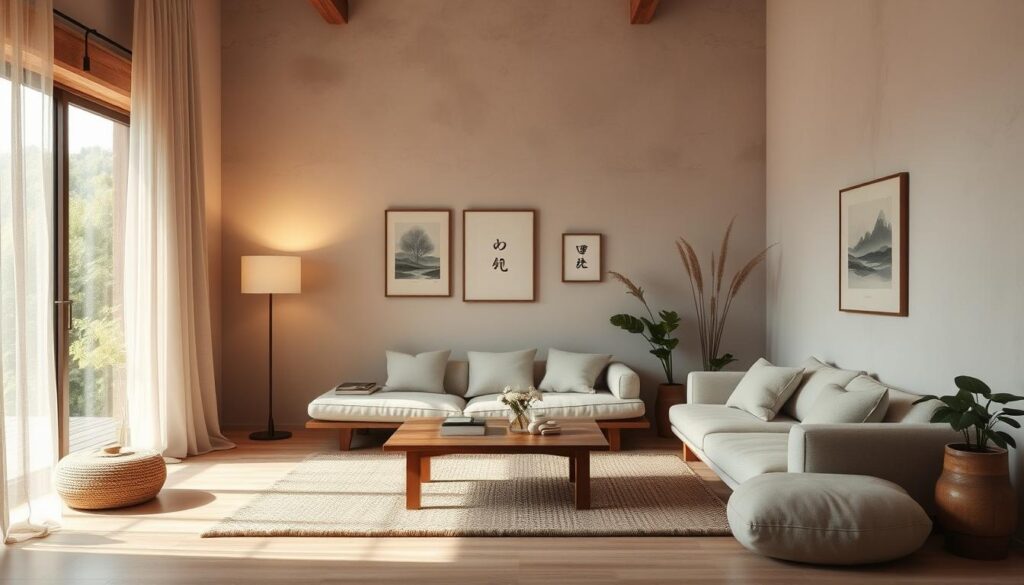
Texturedd Fabrics and Soft Textiles
Look for materials that show their natural origins. Unbleached cotton throws, hand-woven hemp blankets, or raw linen cushions add warmth. Choose fabrics with visible weaves, uneven dye patches, or frayed edges.
These “flaws” become design highlights. Layer them over wooden surfaces or pair with hand-loomed pillows to highlight their natural beauty.
Earthy and Muted Color Palettes
Earthy tones like clay, sandstone, and muted olive green are key. Choose walls in soft taupe, charcoal grays, or weathered wood-inspired hues. Pair cream upholstery with terracotta vases or charcoal ceramic bowls.
These hues avoid bold contrasts, instead using subtle shifts in shade for visual harmony. Muted forest green accents or sand-toned ceramics connect the room to nature’s palette. This embodies the cozy simplicity of wabi sabi’s philosophy.
Furniture Choices for Wabi Sabi Living Rooms
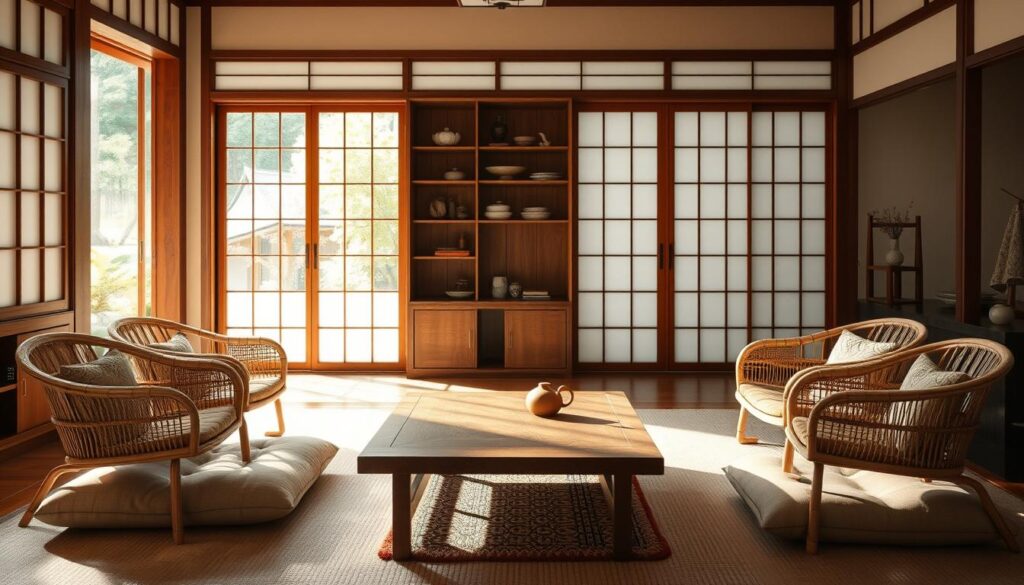
Wabi-sabi living rooms love furniture with a story. Look for items where flaws are part of the design. Pieces made from natural materials like reclaimed wood and leather are key. The Japanese style shines through in their simplicity and asymmetry.
“Wabi-sabi is the beauty of things imperfect, impermanent, and incomplete.” — Leonard Koren
Vintage and Reclaimed Pieces
Vintage tables with their wood grain and scratches have tales to tell. A Lunarys center table, for example, shows off its natural imperfections as art. Leather armchairs with a worn look and cabinets with faded paint show the beauty of repair.
Reclaimed wood stools and shelves bring warmth without the need for perfection.
- Seek flea markets for weathered wood
- Pair antique pieces with modern minimalist decor
- Embrace cracks and stains as character markers
Organic Shapes and Forms
Curves, bends, and irregular shapes remind us of nature. A Cadiz Bench Nude, for instance, has flowing lines that stand out against modern furniture. The Octo Console Table and Palm Mirror show off bold angles and tribal textures, echoing growth.
These shapes reject strict symmetry, embracing the Japanese love for nature.
| Furniture | Material/Design | Wabi-Sabi Trait |
|---|---|---|
| Lunarys Center Table | Travertine with natural cracks | Celebrates imperfection |
| Austria Side Table | Marquetry patterns | Handcrafted natural beauty |
| Cadiz Bench | Undulating wood curves | Fluid organic flow |
Match these pieces with low-profile seating and textured fabrics. This creates a space where every item feels unique, not mass-produced. Let furniture’s uniqueness be its charm.
Creating a Cozy Atmosphere
Turn your living area into a cozy retreat with careful design. Wabi sabi living room design is all about warmth and balance. It mixes function with beauty. Begin by adding different light sources to highlight textures and create cozy shadows.
Layered Lighting Techniques
Natural light is key, but soft artificial light makes it cozier. Here are some ideas:
- Paper lanterns casting gentle glows
- Candle holders in salt-glazed ceramic
- String fairy lights draped casually
| Light Type | Design Purpose |
|---|---|
| Candlelit | Creates organic ambiance |
| Fairy lights | Adds playful warmth |
| Recessed dimmable lights | Adjusts brightness to mood |

Incorporating Plants and Greenery
Make your space lively with plants that show off their natural flaws. Pick hardy types like:
- Bonsai trees in cracked clay pots
- Spider plants in woven macramé hangers
- Bamboo stalks in unglazed terracotta
Place them in a way that looks natural, with different heights. A fern spilling over a rough table adds to the wabi sabi living room interior design inspiration.
Wabi Sabi Color Schemes
Nature’s colors set the mood for Japanese aesthetic interiors. Earth tones create a calm background for spaces that celebrate imperfect beauty. These colors are more than trends; they speak of peace and connection to nature.
Earth Tones: A Foundation
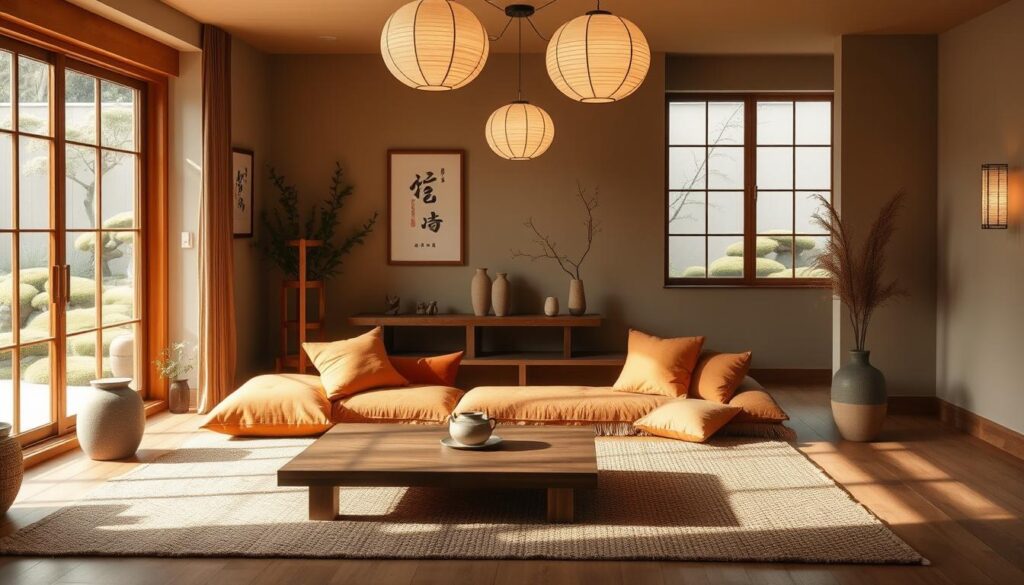
Imagine colors from soil, moss, and weathered wood. Beige, taupe, and soft greens like Benjamin Moore’s “Sage Mist” or Farrow & Ball’s “Soya” bring simplicity. Imperfect beauty is seen in uneven tones: a wall in clay-inspired ochre or a wool throw with brown variations.
Accent Colors to Consider
- Rust: A touch of oxidized copper or terracotta pottery adds warmth without being too much.
- Dusty rose: Soft pink accents, like a hand-dyed cushion or ceramic vase, mimic dried petals.
- Forest green: Darker greens (Behr’s “Evergreen Fog”) contrast nicely against lighter walls.
It’s all about balance—use accents carefully. A single indigo-blue bowl or a weathered driftwood sculpture lets nature’s imperfections shine.
Decor and Accessories for Wabi Sabi
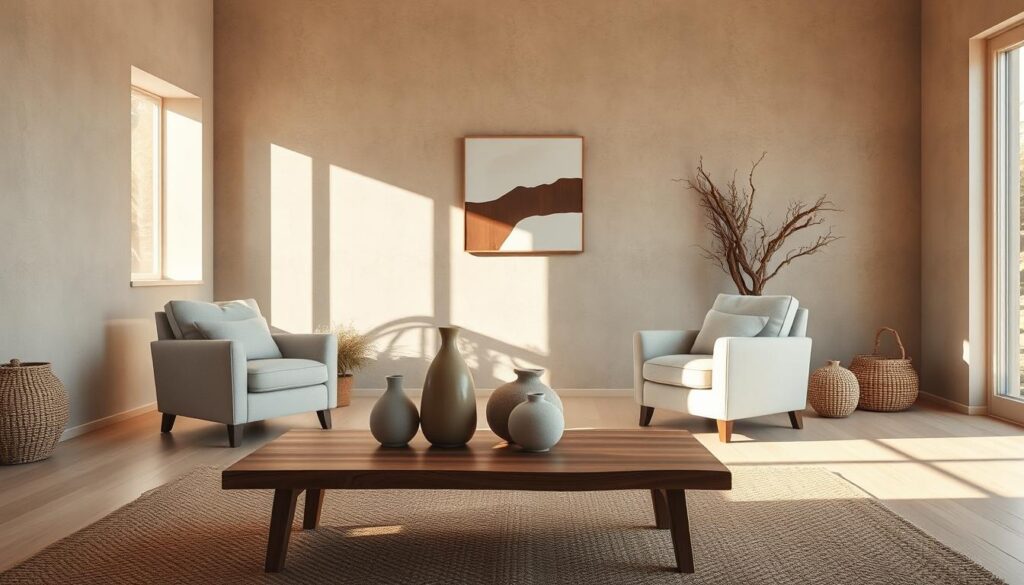
Wabi sabi decor focuses on small details that tell big stories. Handmade pottery, for example, brings warmth with its imperfections. Handcrafted ceramic bowls or vases fixed with gold (a method called kintsugi) stand out. They celebrate history and repair.
Handmade Pottery and Crafts
Artisan-made items like Bizen ware or raku pottery add earthy textures. Look for pieces with uneven glazes or faint cracks. These flaws show their true nature. A distressed clay planter or a basket made from unbleached fibers brings organic charm without cluttering the space.
“Imperfection is not a flaw but a testament to life’s journey.”
Simple, Thoughtful Decor Items
Choose accessories that are both functional and minimalist. Here are some examples:
- Handwoven wool throws draped over chairs
- Unpolished copper candleholders
- Stone sculptures in muted grays or browns
- Hand-carved wooden spoons displayed in open shelving
Natural materials like raw linen, aged wood, or river stones help create a cohesive look. Steer clear of mass-produced items. Instead, choose pieces that show clear craftsmanship. A single hand-thrown ceramic vase means more than many decorative items. Let the space around these pieces highlight their beauty.
Flooring Options for Wabi Sabi Spaces
Natural materials bring authenticity to a wabi sabi living room. Flooring should show texture and imperfection. This reflects the philosophy’s respect for time. Here’s how to pick options that enhance this look:
Natural Wood vs. Stone Flooring
- Reclaimed wood floors have character with knots, cracks, and aged grains. Wide planks in oak or cedar show organic patterns.
- Stone like limestone or tumbled marble adds ruggedness. Decoratori bassanesi’s porcelain stoneware looks natural but needs less care.
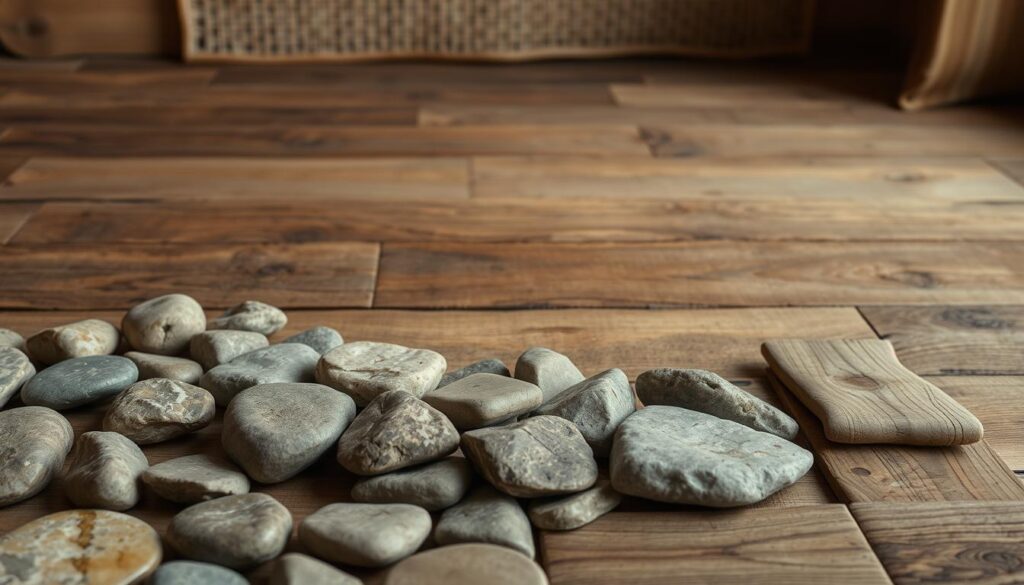
Rugs: Natural Fibers and Textures
Layering rugs from jute, sisal, or undyed wool adds warmth and texture. Choose handwoven pieces with visible fibers—
“A rug’s irregular weave becomes a celebration of craftsmanship, not a flaw,”
says interior designer Lena Torres. Stay away from synthetic blends. Go for fibers that age well over time.
Match materials that change over time. A stone floor with a wool rug brings together earthy tones and different textures. Choose options that welcome imperfection. Let each piece share its story of time and place.
Incorporating Natural Light
Natural light is the heart of wabi-sabi spaces. It mixes cozy simplicity with the Japanese aesthetic. Sunlight turns your room into a lively space where shadows and warmth move with the sun.
Maximizing Windows for Light
- Place seating and decor away from windows to let light flow freely.
- Use low-profile furniture to avoid blocking window views.
- Add mirrors or ceramic tiles to reflect light and amplify brightness.
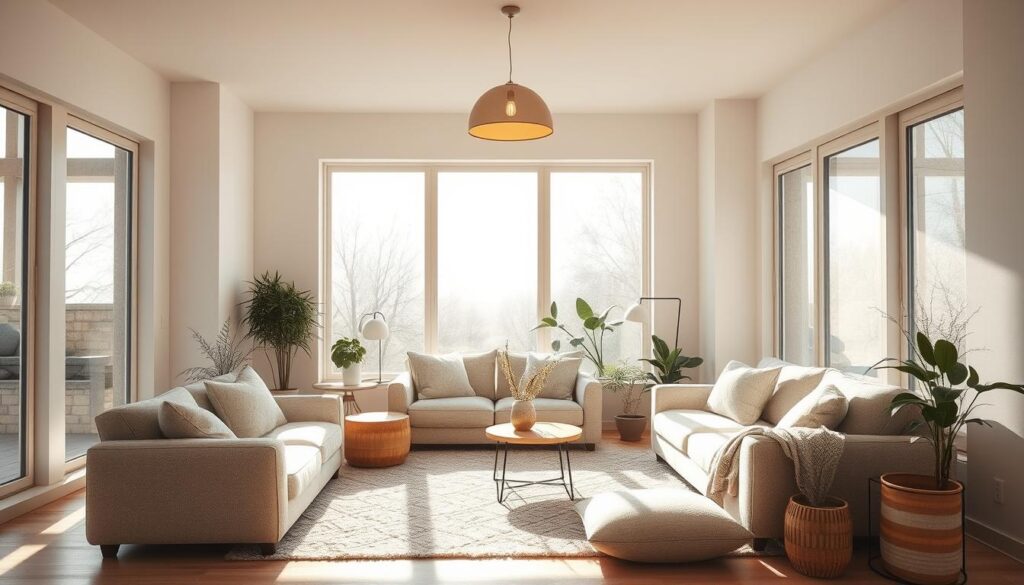
Using Sheer Curtains for Softness
Choose fabrics that soften light without blocking it:
- Linen: Crinkled texture filters light while preserving privacy.
- Cotton gauze: Lightweight and breathable, ideal for diffusing harsh rays.
- Unbleached muslin: Adds a rustic touch while maintaining brightness.
| Material | Light Effect | Aesthetic Benefit |
|---|---|---|
| Linen | Softens glare | Reinforces earthy textures |
| Bamboo blinds | Creates dappled patterns | Aligns with organic forms |
| Rice paper panels | Diffuses warmth | Echoes traditional Japanese aesthetic |
Layering sheer fabrics with wood accents keeps spaces bright yet calm. This shows wabi-sabi’s love for fleeting beauty.
Wall Treatments and Colors
Walls in Wabi Sabi design serve as a backdrop to show imperfect beauty. Choose muted earthy tones like beige or muted greens. Pair these with natural materials that have subtle flaws. These surfaces add depth and embrace organic irregularities.
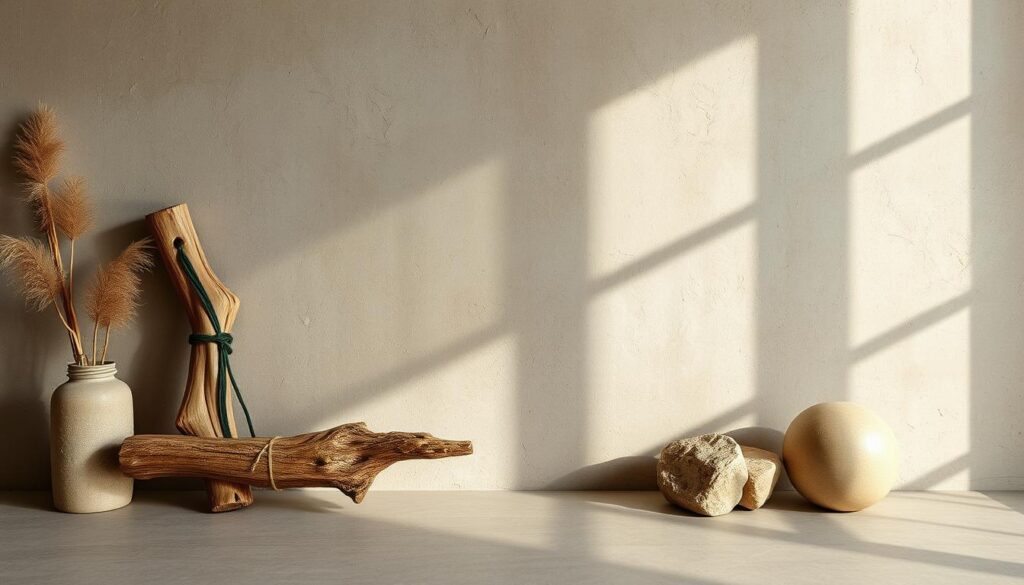
Textured Paint Finishes
Subtle textures warm up a space without bold patterns. Try these techniques:
- Lime wash: Creates a soft, breathable surface with visible brushstrokes.
- Clay paint: Eco-friendly and porous, showing slight imperfections over time.
- Plaster: Cracked or brush-on finishes mimic natural erosion.
Pair these with neutral tones like pale gray or terracotta. This lets textures be the main focus.
Natural Fiber Wall Coverings
Materials like grasscloth or jute add texture without synthetic stiffness. Consider these options:
- Handwoven grasscloth for organic patterns.
- Seagrass panels for coastal-inspired warmth.
- Handmade zellige tiles in muted earth tones.
| Material | Features | Best For |
|---|---|---|
| Grasscloth | Soft drape, natural fibers | Walls needing subtle patterns |
| Zellige Tiles | Hand-glazed edges, irregular shapes | Accent walls or fireplaces |
| Woven Jute | Durable, earthy tones | High-traffic areas |
Let walls evolve naturally—fading near windows or minor cracks add to their imperfect beauty. Choose materials that age gracefully, like clay-based paints or untreated wood paneling.
Minimalism and Wabi Sabi Harmony
Mixing minimalist decor with wabi sabi’s cozy simplicity makes spaces feel both thoughtful and welcoming. This mix highlights clean lines and usefulness. It also welcomes the beauty of natural imperfections.
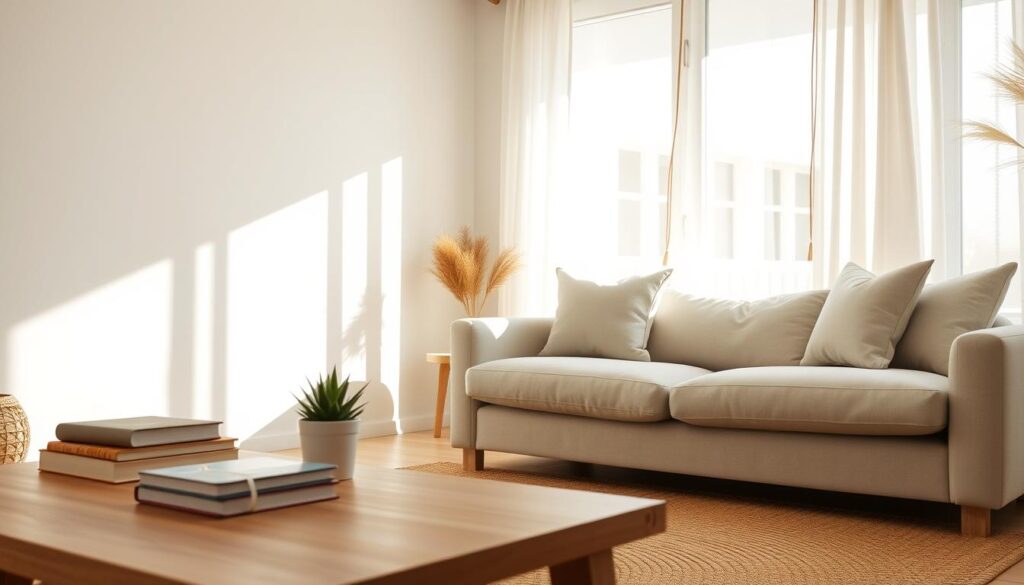
Blend Practicality with Aesthetic Appeal
- Choose minimalist decor with organic textures like weathered wood or rough stone.
- Opt for furniture with simple shapes but made from materials like reclaimed wood to add character.
- Incorporate muted tones like beige or soft greens to anchor the space without overwhelming it.
Declutter Thoughtfully
“The space you live in should speak to the life you love.” — Marie Kondo
Decluttering with cozy simplicity means keeping items that serve a purpose or hold personal meaning. Follow these steps:
- Remove items that don’t add value or beauty to your space.
- Display cherished objects like handcrafted pottery or well-loved textiles to add soul to minimalist decor.
- Use open shelving to showcase a few meaningful items rather than crowded displays.
Natural light and soft lighting, like paper lanterns, enhance this blend. Spaces feel calm yet lived-in. The result? A room that’s both serene and deeply personal.
Personal Touches in Wabi Sabi Design
Wabi sabi living room design is all about personal touches. It combines family history with imperfect beauty. This mix turns spaces into stories of our lives, blending old and new.
Family Heirlooms and Artifacts
Make your space special with family treasures. Think weathered trunks, grandparent’s furniture, or souvenirs from travels. “Items that spark joy and hold memories are central to wabi sabi,” Marie Kondo says.
Pair a rustic chair with a modern sofa. This mix of old and new is seen in Rowena Lei’s designs. She uses unglazed pottery and foraged branches.
“Imperfect beauty shines brightest in objects that tell a story,” says interior designer Karin Sun.
- Display cracked ceramics repaired with gold (kintsugi) to highlight resilience.
- Hang maps, letters, or children’s art on textured walls for layered personal meaning.
The Power of Personal Collections
| Type | Examples | Design Tip |
|---|---|---|
| Natural Objects | Sea glass, river stones, dried flowers | Arrange in mismatched bowls for organic texture |
| Handmade Items | Hand-painted ceramics, woven baskets | Showcase on open shelves to emphasize craftsmanship |
| Cultural Treasures | Antique textiles, traditional carvings | Balance with neutral tones to highlight uniqueness |
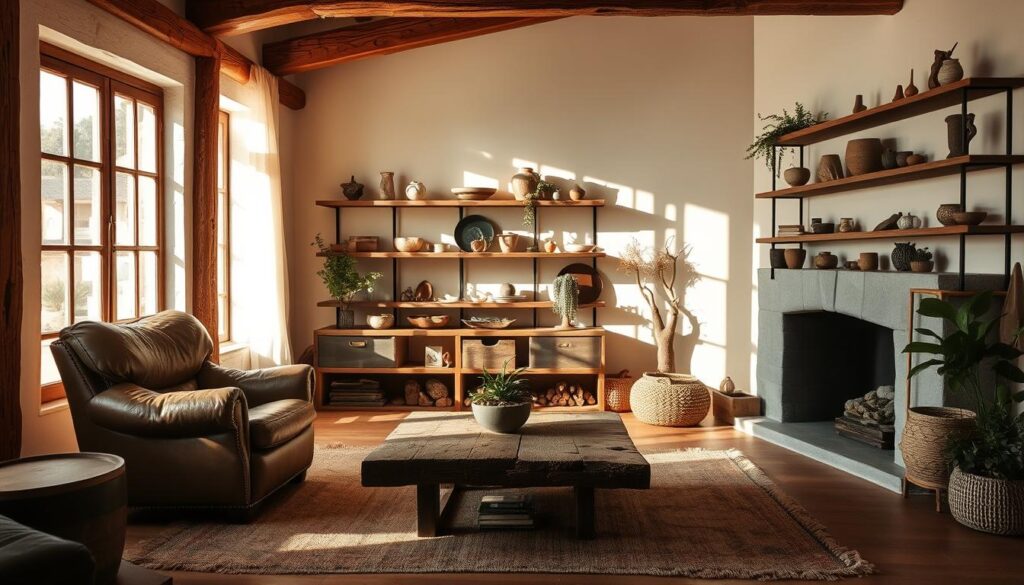
Change your collections with the seasons. Swap out seashells for autumn leaves. This keeps your space lively.
Use natural textures like linen and sisal rugs. They connect personal items to nature’s flow. A wabi sabi room is a place where stories are told, inviting us to pause and think.
Enhancing the Wabi Sabi Experience
Wabi Sabi living rooms are special because they engage all our senses. It’s not just about what we see. Smell, sound, and touch make the space a true sanctuary.
Setting the Mood with Scent
Natural scents are key to the wabi sabi vibe. Hinoki cypress or sandalwood incense fills the air, reminding us of Japanese tea ceremonies. Dried lavender or fresh eucalyptus add a seasonal touch.
Stay away from synthetic sprays. Instead, choose earthy scents like beeswax candles or soy tapers. These simple touches turn a room into a mindful space.
Creating Spaces for Reflection and Balance
Even small spots can be powerful. A corner with a floor cushion and a low table invites quiet. A window nook with a wicker basket chair is perfect for reading.
Pair simple decor like the Ergon I-Wood coffee table with a ceramic tea set. This mix of function and thoughtfulness is beautiful. A small shelf for handmade pottery or dried plants makes a room special.
A wabi sabi space gets better with time. Each imperfection in a vase or the patina on wood tells a story. It shows the beauty in life’s quiet moments.
FAQ
What is wabi sabi in interior design?
Wabi sabi is an ancient Japanese design philosophy. It celebrates the beauty of imperfection and natural aging. It also values simplicity. This philosophy helps create authentic and peaceful living spaces that reflect personal character.
How can I incorporate wabi sabi principles into my living room?
Use natural materials and vintage or reclaimed furniture. Choose textured fabrics and an earth-toned color palette. This will make your living room cozy and inviting.
What types of furniture work best in a wabi sabi living room?
Look for furniture that shows wear and has character. Vintage, antique, and reclaimed pieces are great. Choose furniture with organic shapes that reflect nature.
How important are natural materials in wabi sabi design?
Natural materials like wood, stone, and clay are key in wabi sabi design. They create authentic and grounding spaces. These materials develop a beautiful patina over time, adding value and narrative to your home.
What color palette should I use for a wabi sabi living room?
Use an earthy and muted color palette. Shades inspired by nature, like clay, stone, sand, and greens, are ideal. They foster a calming and harmonious atmosphere.
How can I enhance the lighting in my wabi sabi living room?
Use soft and ambient lighting to create a cozy atmosphere. Combine natural light with paper lanterns, ceramic lamps, and candles. This provides gentle illumination that highlights the natural textures in your space.
Can I add personal touches to my wabi sabi decor?
Absolutely! Adding family heirlooms, unique artifacts, and curated collections adds character and warmth. It turns your living room into a reflection of your personal story.
Are there specific flooring options that suit wabi sabi interiors?
Yes, natural wood and stone flooring are excellent choices. Look for wide planks, reclaimed timber, or textured stone. These options will age beautifully and contribute to the space’s warmth.
What types of decorative accessories should I choose?
Choose handcrafted pottery, simple decor items, and meaningful objects. They should embody wabi sabi principles. Items should have personal significance, be made from natural materials, and contribute to a sense of authentic simplicity.
How do I achieve a balanced and inviting atmosphere in my living room?
Create space through natural light, thoughtful decor, and a balance of textures and colors. Incorporate elements of nature, like plants, to enhance the relaxed and nurturing environment characteristic of wabi sabi.

